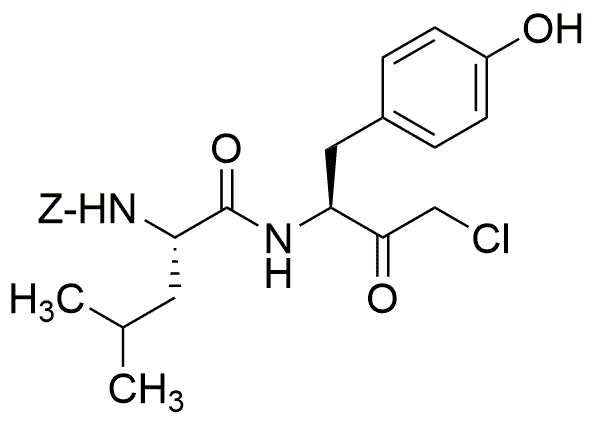Z-Leu-Tyr-chloromethylketone is widely utilized in research focused on:
- Peptide Synthesis: This compound serves as a valuable building block in the synthesis of peptides, particularly in the development of biologically active molecules. Its unique structure allows for the incorporation of specific amino acids, enhancing the functionality of the resulting peptides.
- Drug Development: In pharmaceutical research, it is used to create inhibitors for various enzymes, particularly those involved in cancer and metabolic diseases. Its ability to selectively target these enzymes makes it a crucial component in the design of new therapeutic agents.
- Biochemical Research: Researchers utilize this compound to study protein interactions and functions. By modifying proteins with this chemical, scientists can gain insights into cellular processes and disease mechanisms.
- Diagnostic Applications: It can be employed in the development of diagnostic tools, particularly in assays that require specific binding interactions. Its specificity can improve the sensitivity and accuracy of these tests.
- Cosmetic Formulations: The compound is also explored in cosmetic chemistry for its potential to enhance skin penetration of active ingredients, thereby improving the efficacy of skincare products.
General Information
Properties
Safety and Regulations
Applications
Z-Leu-Tyr-chloromethylketone is widely utilized in research focused on:
- Peptide Synthesis: This compound serves as a valuable building block in the synthesis of peptides, particularly in the development of biologically active molecules. Its unique structure allows for the incorporation of specific amino acids, enhancing the functionality of the resulting peptides.
- Drug Development: In pharmaceutical research, it is used to create inhibitors for various enzymes, particularly those involved in cancer and metabolic diseases. Its ability to selectively target these enzymes makes it a crucial component in the design of new therapeutic agents.
- Biochemical Research: Researchers utilize this compound to study protein interactions and functions. By modifying proteins with this chemical, scientists can gain insights into cellular processes and disease mechanisms.
- Diagnostic Applications: It can be employed in the development of diagnostic tools, particularly in assays that require specific binding interactions. Its specificity can improve the sensitivity and accuracy of these tests.
- Cosmetic Formulations: The compound is also explored in cosmetic chemistry for its potential to enhance skin penetration of active ingredients, thereby improving the efficacy of skincare products.
Documents
Safety Data Sheets (SDS)
The SDS provides comprehensive safety information on handling, storage, and disposal of the product.
Product Specification (PS)
The PS provides a comprehensive breakdown of the product’s properties, including chemical composition, physical state, purity, and storage requirements. It also details acceptable quality ranges and the product's intended applications.
Certificates of Analysis (COA)
Search for Certificates of Analysis (COA) by entering the products Lot Number. Lot and Batch Numbers can be found on a product’s label following the words ‘Lot’ or ‘Batch’.
*Catalog Number
*Lot Number
Certificates Of Origin (COO)
This COO confirms the country where the product was manufactured, and also details the materials and components used in it and whether it is derived from natural, synthetic, or other specific sources. This certificate may be required for customs, trade, and regulatory compliance.
*Catalog Number
*Lot Number
Safety Data Sheets (SDS)
The SDS provides comprehensive safety information on handling, storage, and disposal of the product.
DownloadProduct Specification (PS)
The PS provides a comprehensive breakdown of the product’s properties, including chemical composition, physical state, purity, and storage requirements. It also details acceptable quality ranges and the product's intended applications.
DownloadCertificates of Analysis (COA)
Search for Certificates of Analysis (COA) by entering the products Lot Number. Lot and Batch Numbers can be found on a product’s label following the words ‘Lot’ or ‘Batch’.
*Catalog Number
*Lot Number
Certificates Of Origin (COO)
This COO confirms the country where the product was manufactured, and also details the materials and components used in it and whether it is derived from natural, synthetic, or other specific sources. This certificate may be required for customs, trade, and regulatory compliance.


